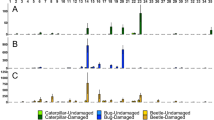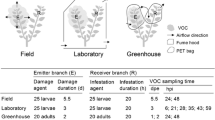Abstract
Volatile communication allows plants to coordinate systemic induced resistance against herbivores. The mechanisms responsible and nature of the cues remain poorly understood. It is unknown how plants distinguish between reliable cues and misinformation. Previous experiments in which clipped sagebrush branches were bagged suggested that cues are emitted or remain active for up to 3 days. We conducted experiments using plastic bags to block emission of cues at various times following experimental clipping. We also collected headspace volatiles from clipped and unclipped branches for 1 h, transferred those volatiles to assay branches, and incubated the assays for either 1 or 6 h. We found that assay branches that received volatile cues for less than 1 h following clipping of neighbors failed to induce resistance. Assay branches that received volatile cues for more than 1 h experienced reduced herbivory throughout the season. Branches incubated for 6 h with volatiles that had been collected during the first hour following clipping showed induced resistance. These results indicate that sagebrush must receive cues for an extended time (>1 h) before responding; they suggest that the duration of cue reception is an important and overlooked process in communication allowing plants to avoid unreliable, ephemeral cues.


Similar content being viewed by others
References
Arimura G, Shiojiri K, Karban R (2010) Acquired immunity to herbivory and allelopathy caused by airborne plant emissions. Phytochemistry 71:1642–1649
Bradbury JW, Vehrencamp SL (1998) Principles of animal communication. Sinauer, Sunderland
Cipollini DF (1997) Wind-induced mechanical stimulation increases pest resistance in common bean. Oecologia 111:84–90
Farmer EE, Ryan CA (1990) Interplant communication: airborne methyl jasmonate induces synthesis of proteinase inhibitors in plant leaves. Proc Natl Acad Sci 87:7713–7716
Frost CJ, Appel HM, Carlson JD, De Moraes CM, Mescher MC, Schultz JC (2007) Within-plant signaling via volatiles overcomes vascular constraints on systemic signaling and primes responses against herbivores. Ecol Lett 10:490–498
Gotelli NJ, Ellison AM (2004) A primer of ecological statistics. Sinauer, Sunderland
Heil M, Karban R (2010) Explaining evolution of plant communication by airborne signals. Trends Ecol Evol 25:137–144
Heil M, Silva Bueno JC (2007) Within-plant signaling by volatiles leads to induction and priming of an indirect plant defense in nature. Proc Natl Acad Sci 104:5467–5472
Hilker M, Meiners T (2006) Early herbivore alert: insect eggs induce plant defense. J Chem Ecol 32:1379–1397
Karban R (2008) Plant behavior and communication. Ecol Lett 11:727–739
Karban R, Agrawal AA, Thaler JS, Adler LS (1999) Induced plant responses and information content about risk of herbivory. Trends Ecol Evol 14:443–447
Karban R, Shiojiri K, Huntzinger M, McCall AC (2006) Damage-induced resistance in sagebrush: volatiles are key to intra- and interplant communication. Ecology 87:922–930
Karban R, Shiojiri K, Ishizaki S (2010) An air transfer experiment confirms the role of volatile cues in communication between plants. Amer Nat 176:381–384
Kessler A, Halitschke R, Diezel C, Baldwin IT (2006) Priming of plant defense responses in nature by airborne signaling between Artemisia tridentata and Nicotiana attenuata. Oecologia 148:280–292
Kim J, Quaghebeur H, Felton GW (2011) Reiterative and interruptive signaling in induced plant resistance to chewing insects. Phytochemistry 72:1624–1634
Orians C (2005) Herbivores, vascular pathways, and systemic induction: facts and artifacts. J Chem Ecol 31:2231–2242
Peiffer M, Tooker JF, Luthe DS, Felton GW (2009) Plants on early alert glandular trichomes as sensors for insect herbivores. New Phytol 184:644–656
Preston CA, Laue G, Baldwin IT (2004) Plant-plant signaling: application of trans- or cis-methyl jasmonate equivalent to sagebrush releases does not elicit direct defenses in native tobacco. J Chem Ecol 30:2193–2214
Rodriguez-Saona CR, Rodriguez-Saona LE, Frost CJ (2009) Herbivore induced volatiles in the perennial shrub, Vaccinium corymbosum, and their role in inter-branch signaling. J Chem Ecol 35:163–175
Rodriguez-Soana C, Thaler JS (2005) The jasmonate pathway alters herbivore feeding behavior: consequences for plant defences. Ent Exp et Appl 115:125–134
Schaefer HM, Ruxton GD (2011) Plant-animal communication. Oxford Press, Oxford
Shiojiri K, Karban R (2006) Plant age, communication, and resistance to herbivores: young sagebrush plants are better emitters and receivers. Oecologia 149:214–220
Shiojiri K, Karban R, Ishizaki S (2009) Volatile communication among sagebrush branches affects herbivory: timing of active cues. Arthropod Plant Interact 3:99–104
Takahaski M, Huntley N (2010) Herbivorous insects reduce growth and reproduction of big sagebrush (Artemisia tridentata). Arthropod Plant Interact 4:257–266
Viswanathan DV, Thaler JS (2004) Plant vascular architecture and within-plant spatial patterns in resource quality following herbivory. J Chem Ecol 50:531–543
Wiens JA, Cates RG, Rotenberry JT, Cobb N, Van Horne B, Redak R (1991) Arthropod dynamics on sagebrush (Artemisia tridentata): effects of plant chemistry and avian predation. Ecol Monogr 61:299–321
Young JA, Evans RA, Major J (1988) Sagebrush steppe. In: Barbour MG, Major J (eds) Terrestrial vegetation of California, 2nd edn. California Native Plant Society Special Publication 9, Sacramento, pp 763–769
Acknowledgments
Our experiments were conducted at the UC Sagehen Natural Reserve in the Tahoe National Forest, and we thank Jeff Brown for facilitating our work there. We were supported by grants from the JSPS.
Author information
Authors and Affiliations
Corresponding author
Additional information
Handling Editor: Robert Glinwood.
Rights and permissions
About this article
Cite this article
Shiojiri, K., Karban, R. & Ishizaki, S. Prolonged exposure is required for communication in sagebrush. Arthropod-Plant Interactions 6, 197–202 (2012). https://doi.org/10.1007/s11829-011-9180-1
Received:
Accepted:
Published:
Issue Date:
DOI: https://doi.org/10.1007/s11829-011-9180-1




